Winners of the 2022 Murray & Murray Competition
September 16, 2022
The 2022 Murray & Murray Competition attracted 155 entries from students across the school who submitted drawings on the theme of Time Matter[s].
The jury selected three Murray & Murray Prize winners and five Honour Award recipients. They received a total of $7,000 in cash prizes.
See images, descriptions, and jury comments below.
“I want to thank the jury and also congratulate all the students for participating in this competition in a very short time,” said Interim Director Federica Goffi. “Seeing the school coming together in this way is wonderful.”
The Murray & Murray Competition is a seven-day drawing competition that takes place in the first week of the Fall Term and celebrates the start of a new school year.
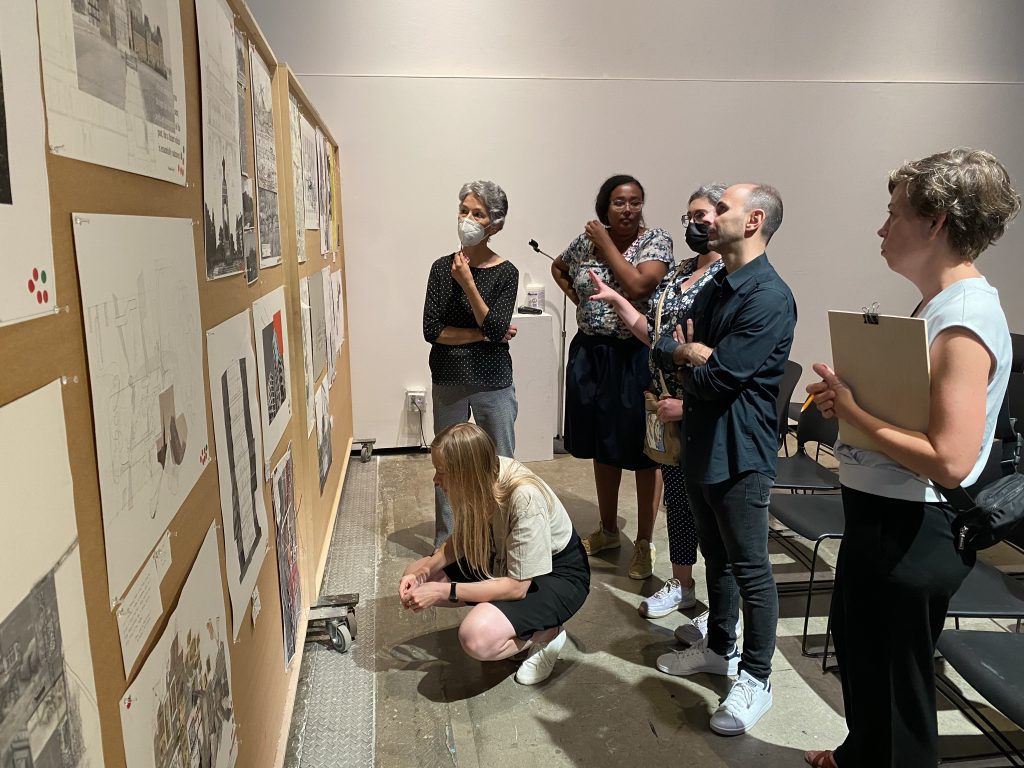
The Murray & Murray jury deliberates in the pit.
Dr. Goffi launched the competition on September 7 with the prompt: What is the time-matter at hand in the making of a building?
“You are invited to explore two temporal conditions —merging them onto a new medium: a photograph of a site or building printed on paper, over which a sectional representation realizes a contiguous imagery of past and future events, evoking the process through which memory traces overlay in the imagination,” she said.
The results were announced on September 13 at an awards ceremony in the Pit at the Architecture Building. Watch it here.
Out of 155 entries, studio faculty members chose 20 finalists for consideration by the following jury members.
• Dr. Konstantinos Avramidis, lecturer in Architecture and Landscapes at the University of Cyprus
• Dr. Menna Agha, assistant professor, ASAU
• Lyette Fortin, adjunct professor, ASAU
• Dr. Lisa Moffitt, associate professor, ASAU
• Dr. Omeasoo Wahpasiw, assistant professor, ASAU
• Isabel Potworowski, PhD student and contract instructor, ASAU
Tim Murray, the retired Ottawa architect, who endowed the prize in 2003, was unfortunately unable to join the jury this year as he has in past years.
The event concluded with a presentation by Dr. Avramidis on Graffiti, Street Art, and Buildings as unsolicited drawing surfaces.
First Prize ($2,000)
Basil Currie, 4th-year BAS (Conservation & Sustainability)
Title: Fossils of the Future
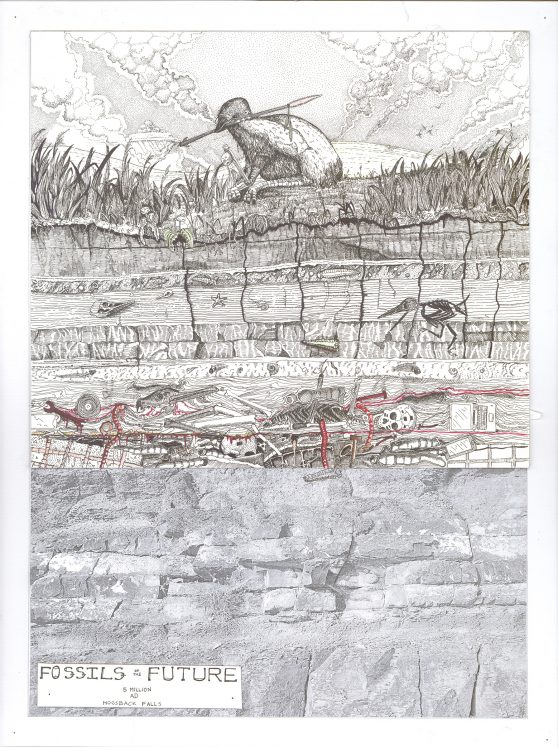
Description: This piece is about the land, nature, and what changes over geologic time. Fossils show that humanity is long extinct. On top of the cliff, a bird perches as it holds a spear, revealing that nature has not only recovered from but has also replaced humanity. Five million years ago, humans were no more than apes. Currently, crows are just as intelligent as primates. Given another five million years, perhaps crows could replace our species if we go extinct.
Jury Comments: What we really appreciated is the fact that everything comes from the land; that’s the basis of everything. The land will continue and survive but we might destroy ourselves. There’s a great story in there and it’s a wonderful drawing. Your technique is so good. Here’s a very interesting reconstruction of death, a piece that sits in a post-humanist realm. The fact that humans are not the centre of this says it all.
Second Prize ($1,500)
Sonia Xu, 3rd-year BAS (Design)
Title: The Memory and Imagination of a Fallen Tree

Description: A tribute to a tree that once stood on the edge of the Hartwell Locks. When it fell during the storm in May, I photographed it. I nestled my memories of traveling between the studio and canal to visit it. I looked into the cracked and twisting wood to dream up caverns of imagination. The fallen tree holds memories of its own life, those who knew it, and the potential of past and future inspiration.
Jury Comments: This one created in us the most emotion. The buildings are there, but they’re not dominating the story. The story is really from the perspective of this tree and centering that life-giving force in the work. I really appreciate your use of colour. I loved the liquid quality of the drawing. What you have done is subverted an inherently violent piece of drawing which is a section — a section is when you cut something — but the water just made everything dissolve.
Third prize ($1,000)
George Gialouris-Tsivikas, 3rd-year BAS (Design)
Title: Szimpla Kert: Ghetto, Shelter, Ruin Bar
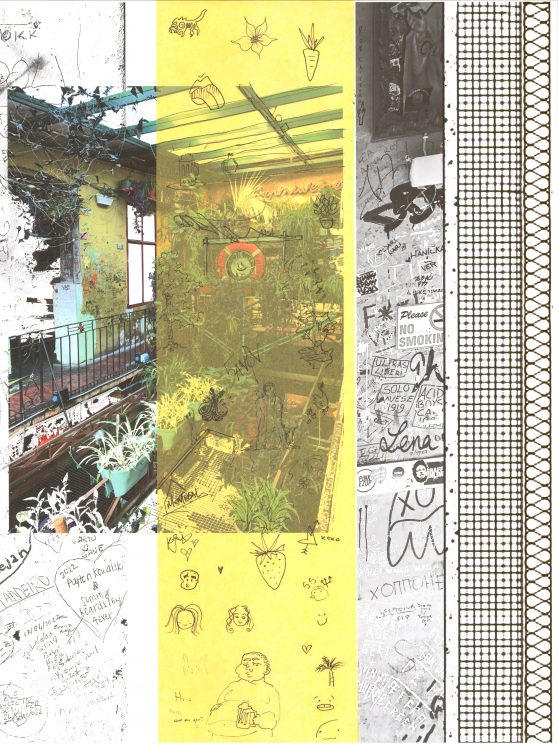
Description: This drawing is a love letter to the city of Budapest. Located in the Jewish quarter, the building has sheltered youth and outcasts and is now a ruin bar. Inside, the walls are covered in graffiti and tags left behind by visitors. This project depicts a chrono-section that cuts through a wall in Szimpla Kert, inviting the viewer to participate in the drawing and leave their mark, as the walls do in the building.
Jury Comments: You conceptually nailed it. With the addition of the layer and the pen … this is an open-ended project. We can keep adding and removing and writing on top of each other for eternity. At the same time, it shows us the potentiality of architecture becoming something more than an architectural ego and becoming a participatory project. You transferred the agency from the architect and the architecture to all of us. We need to remember that architecture is multi-authored.
Honour Award ($500)
Elisa Antunes, 2nd-year BAS (Design)
Title: Spirit of Abandonment: The Life Cycle of a Building, 2024

Description: If architecture is conceptually in dialogue with its inhibitors, what would result when these inhibitors become absent? Does a piece of architecture’s essence and identity become lost along with its occupiers? This reflection pushed me to analyze the life cycle of a building and represent that the constant attempt to reclaim can be harmful, and that eventually, all comes to die.
Jury Comments: In terms of storytelling and the clarity of the story, this drawing does a really great job. It integrates the section and the photo very well, so there is this ambiguity. It’s very connected, almost like puzzle pieces being put together. It goes through all aspects of the life cycle of the building. There’s a hint of how the building used to be when it was like new, and then we see a certain poverty. New life could emerge from this building. If that doesn’t happen, then nature simply takes over.
Honour Award ($500)
Ksheel Shetty, 1st year MArch 1
Title: The National War Monument Edifice Apparition

Description: The site of the National War Monument once housed a post office that served politicians and officials. It was reconstructed after a 1904 fire. The rendering attempts to narrate the construction and phases of the site, Connaught Place to Confederation Square. Parcels and leaflets dissipate through the edifice, symbolizing the exchanges of time and interactions, from bustling chaos to quiet remembrance.
Jury Comments: Your piece represented to me ghosts of the past, and the post office being a particularly poignant ghost in regard to a colonial system. This is Algonquin Anishinaabe territory, the post office representing that bastion of the colonial powers. The way the drawing looks to me is it’s a ghost that is haunting something. What’s it haunting? The war memorial. The message that I took from your very nice drawing is that when we allow the ghosts that haunt us to continue to haunt us and don’t address them, we will end up with war and violence.
Honour Award ($500)
Mya Thomas, 2nd-year BAS (Design)
Title: The Hub – Modern-day Passageways Through History
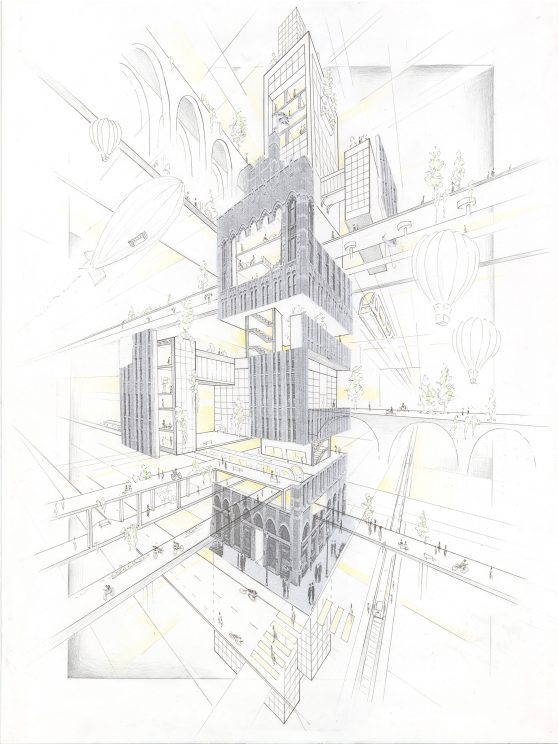
Description: Located where the Calgary Herald building once was, the building unfolds and deconstructs to reveal a busy morning in downtown Calgary.
Jury Comments: Although it is a futuristic sort of drawing, it felt a bit nostalgic in the sense that it shows a future in the manner that used to be, the way we used to imagine the future in the past. Quite literally, the future in this drawing explodes and builds up upon the past. It’s also a sort of photorealism of the past. What’s quite interesting in terms of storytelling are the multi-temporal dimensions.
Honour Award ($500)
Yiping Zhang, 3rd-year BAS (Design)
Title: Chuanda in its Memories of Time
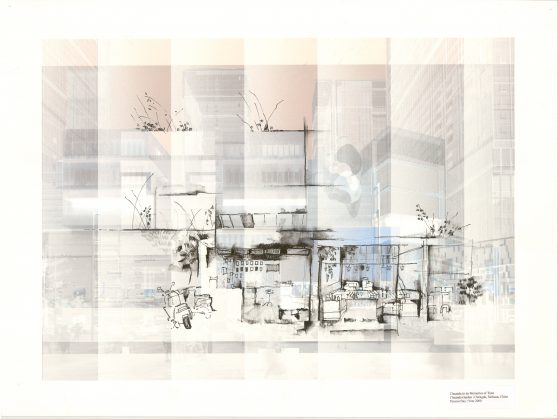
Description: Growing up in Chuanda, China, the visual fabric of my neighbourhood consisted of small local shops. As time passed, some of the local shops were demolished and replaced with newer shopping centres. What were plazas and small apartments flowing with rooftop plants are now polished glass commercial centres.
The drawing illustrates how my connection with Chuanda is defined by my early photographic memories, even through a landscape constantly evolving through time.
Jury Comments: This drawing met all the requirements of the competition with a photo, drawing, and section. The fact that you had ink, a traditional way of drawing, captured so well the original place that you remember superimposed on this non-descript urban scape. You can see that this place had meaning for you and that you really belonged to this place. It’s kind of a sad story because so many places that we cherish disappear…to make way for new.
Honour Award ($500)
Karyn Colenutt, 2nd year BAS (Design)
Title: Disappearing Communities
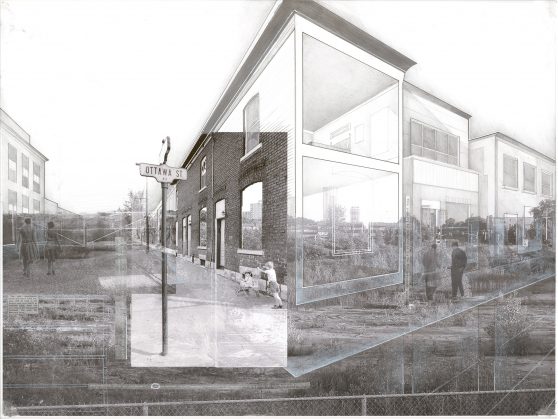
Description: This project expands on an image of LeBreton Flats from 1963 by recreating an imagined streetscape shortly before the neighborhood’s demolition. The drawing is layered with current photos of the now empty site. It examines the contrast between the present-day condition and the previously existing historic community.
Jury Comments: It’s an immersive drawing. I use that term because of the choice of perspective. It really situates the viewer within the context, the site of speculation, and because of the choice of media and the layering up of photograph and drawing. What I really appreciated about the work was the skillful integration of photograph and drawing. One doesn’t really dominate over the other. They each play a very particular role and they work well together compositionally. What I appreciated about this student’s work is that they chose a context that really mattered, a history that needed to be told.
Finalists
Reem Khanafer, 4th-year BAS (Design)
Title: Forgotten Timescapes
Description: A commentary on conservation in the case of Sparks Street and how retaining only the facades of some of its historical buildings does not bring it back to its vibrant history as an outdoor mall. Rather, it helps reduce the street to an empty shell for the development of corporate buildings beyond.

Venus Chau, 2nd-year BAS (Design)
Title: The Return to Nature
Description: Throughout time, we’ve created spaces within nature. Starting with huts and other primitive forest dwellings to the treehouses we’re familiar with today. So many stories have and will be written about and in these spaces. This piece touches on both the past as well as the possibilities of the future. With so much left untouched, the blank space is for the hereafter as we return to nature.

Emilio Hechanova, 3rd-year BAS (Design)
Title: Anatomy of Now
Description. The strong and connected Ottawa community of Heron Gate is currently facing housing issues such as power of ownership and demovictions due to the city’s desire for new and modern residential housing in the area. I split up the composition into three parts. The bottom shows the original houses inhabited by lower to medium-income families, and the middle and top parts shows the new developments for middle to higher-income families and individuals. I compiled these different types of buildings on top of each other and eventually cut through all of the floors to reveal the problems that arise because of the introduction of expensive and luxurious housing.

Marco Vukovic, 1st year of MArch 1
Title: Invisible Lines
Description: In the summer, I passed by this building in Belgrade, Serbia. I was struck by the presence of this damaged artifact of Yugoslavian modernism, with its remnants of destruction still standing for over 20 years. My drawing seeks to depict the “ghost” that once existed in the (quite literal) section-cut of this building. Dated in the present (2022), the drawing is from the perspective of an observer looking into the past.

Ava Cannizzaro, 3rd-year BAS (Design)
Title: Changes Through Time
The history of the Parliament building is expressed through a single design that reflects all ages of its time; past, present, and future. It was built with inspiration from its past, and the quote by Norman Foster increases the significance of its storytelling. Overlapping different visuals on top of the original building, creating a collage, depicts the evolution of time and changes that may be experienced and developed for the Parliament’s future.
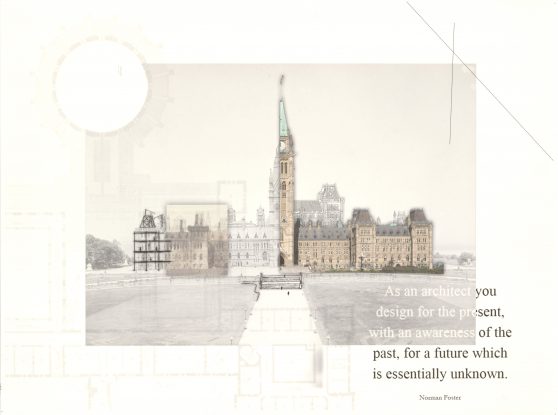
Hugo Jacques, 3rd year BAS (Design)
Title: Bridging Through Time
Description: The idea of this drawing was to bridge two different realities apart from each other, the past and the future. The left side consists of more of a medieval look to it finding itself in the years of the 1450s. The right side was focused on a more futuristic possibility that architecture could bring, something more post-apocalyptic and cyberpunk. A building style that I love very much, even more, when using ink and pen as my art medium.
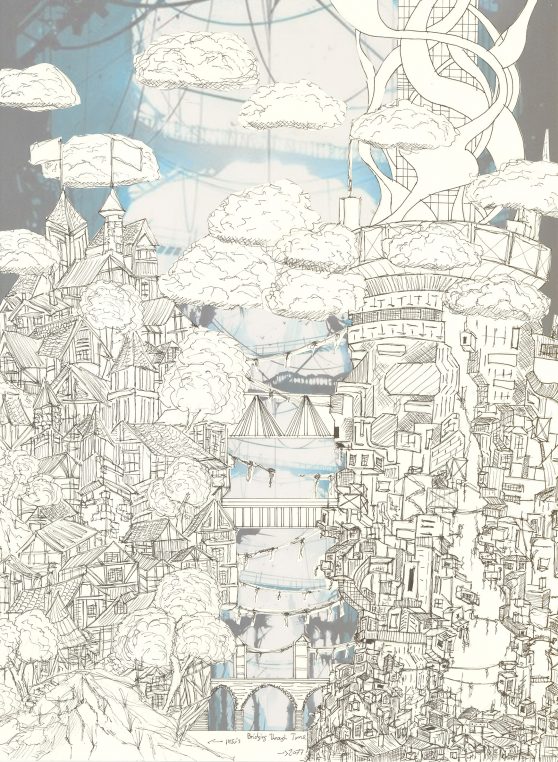
Bryan Ye, 4th-year BAS (Design)
Title: Senzo Tempo, location: Paris, time: less.
His theory (Eugene Emmanuel Viollet-le-Duc) involved the act of reinstating a condition of completeness inspired by a principle of ‘unity of style’ that a building might have never reached before; essentially being an operation that places buildings ‘outside of time’ altogether.” – Federica Goffi. Time Matter(s): Invention and Re-Imagination in Built Conservation.
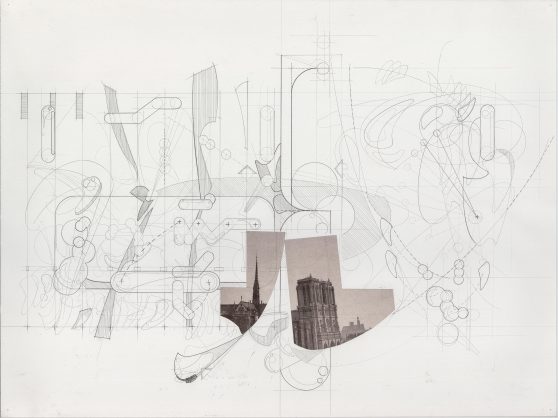
Oshan Tan, 2nd-year BAS (Design)
Title: Disentanglement of Construction
Description: The process of man’s creation of urban environment. Unravelling the ways in which things are created through the use of organic materials in order to create a foundation for our society. Fragmented and distorted in order to reveal how destructive our evolution has been to the earth’s ecosystem.
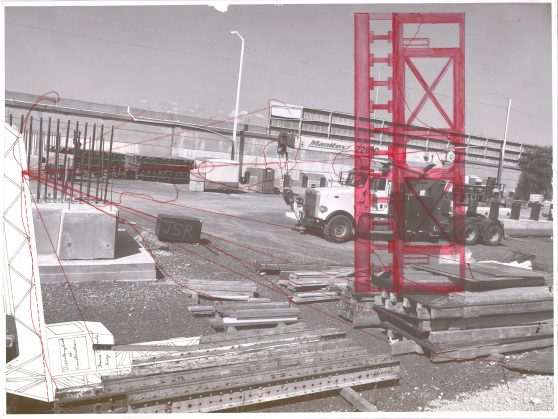
Chrishan Mercurio, 4th-year BAS (Conservation & Sustainability)
Title: Expedition 1907
Les Docks de Paris | France
A time travel from 1907 to the future
“Architecture and conservation are perceived in the contemporary Western world as disjointed, even entities. Instead they need to be merged into a hyphened practice of built conservation, moving beyond a mere juxtaposition of neighbouring fields. A crucial element to be considered for the actualization of a hybrid merging is architecture’s fourth dimension. By rediscovering the temporal dimension of making, both buildings and drawings could be newly interpreted as a slow fast-track, an un-finished work-in-progress by multiple authors, rather than as the product of a singular epoch and author.” Federica Goffi, Time Matter(s): Invention and Re-Imagination in Built Conservation
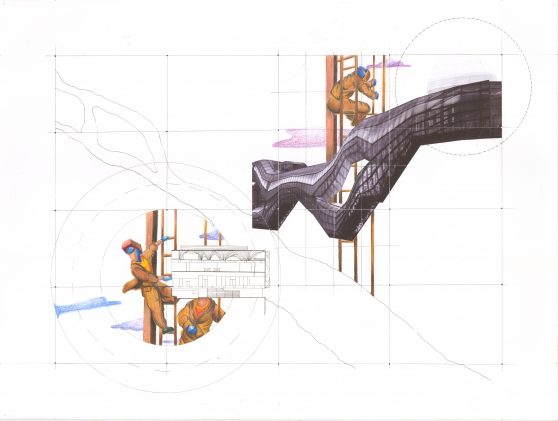
Stephanie Opdebeek, 3rd BAS (Design)
Title: Imagining Brussels
Description: Brussels is a place that I visited when I was young but haven’t been to since. I fell in love with the architecture of the Grand Place, and I remember how amazing and playful it felt to be in such a busy central space. So I wanted to create a drawing that showed the extremely detailed architecture, seemingly still in time, overlayed with playful section drawings depicting how one might experience the architecture in a different way than it was intended, the way that I remember it from when I was young.
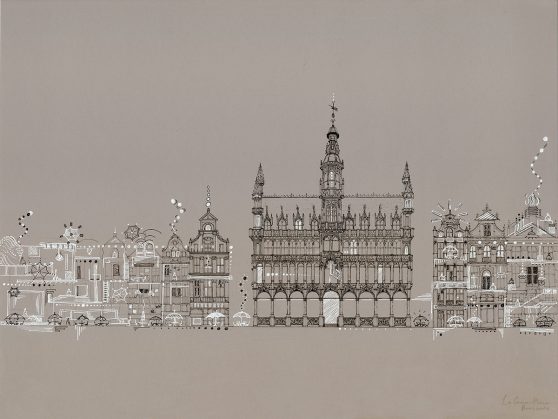
Yawen Freya Xiao, 4th-year BAS (Design)
Title: Wisdom of the Past Enlightens the Future.
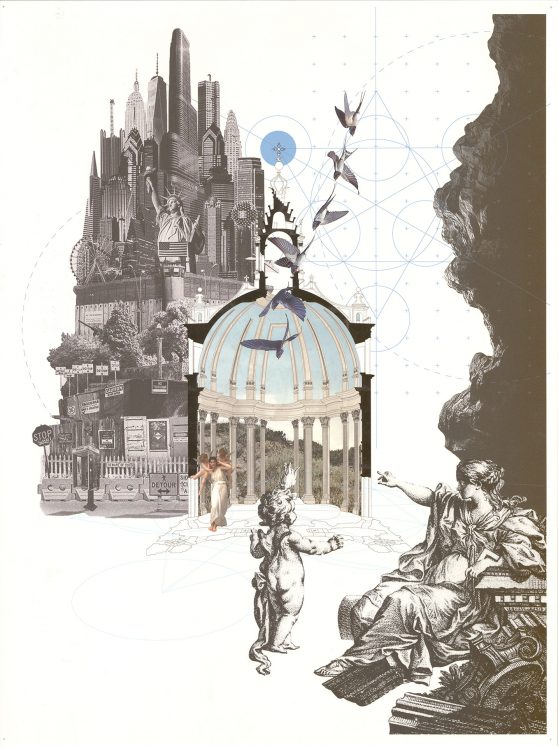
Yourwin Costales, 3rd-year BAS (Design)
